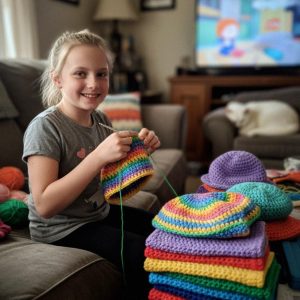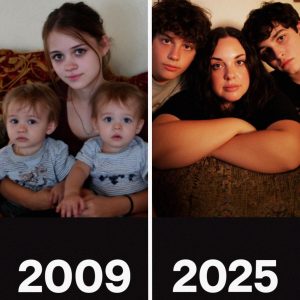Paragraph 1:
The story begins with a storm and a shocking revelation: Hannah’s sister, Megan, arrives soaked and shaken, holding a DNA report and a little girl named Ava. Megan explains that a routine family-history DNA test revealed Ava is Hannah’s biological daughter—something Hannah never expected to confront again. The revelation forces Hannah to revisit the most painful chapter of her past: at twenty-two, overwhelmed, broke, abandoned by the baby’s father, and convinced adoption was the only responsible choice, she relinquished her newborn after only four hours together. Now she learns that the adoptive couple lost custody due to neglect, and Ava has spent years in foster care. The system failed her, not Hannah, but the guilt strikes like a physical blow. The moment Hannah sees Ava quietly playing in the next room, the word “daughter” lands with irreversible force, along with fear and an overwhelming sense of responsibility.
Paragraph 2:
Unsure what to do, Hannah confides everything to her partner, Lewis, expecting the truth to strain or even destroy their relationship. Instead, he chooses compassion and partnership, insisting that if they have a chance to do right by this child, they will face it together. What follows is an exhausting, highly scrutinized process: paperwork, background checks, interviews, social worker visits, and constant emotional tension. Hannah must repeatedly defend her past choices to strangers who hold the power to determine whether she is fit to regain custody. She admits her past mistakes openly but emphasizes that she is no longer the frightened young woman she once was. Throughout it all, Megan becomes Hannah’s fiercest advocate—writing letters, attending meetings, and applying pressure wherever she can. Her devotion is unwavering even though she, too, has bonded deeply with Ava. Months of bureaucratic hurdles and emotional turmoil finally culminate in a courtroom ruling that grants Hannah custody, giving her a second chance she never thought possible.
Paragraph 3:
Bringing Ava home is both joyful and terrifying. The little girl is polite, quiet, and hesitant—moving through the house as if she doesn’t want to trouble anyone. Hannah and Lewis avoid overwhelming her, instead gently building trust in ordinary, intimate ways: letting her choose her room’s paint colors, discovering her food preferences, and observing the small habits that make her who she is. Ava sleeps clutching a stuffed giraffe and calls them by their first names, a reminder of all the years Hannah missed. Every moment is fragile, uncertain, and filled with silent questions about whether Ava will ever feel safe, connected, and wanted. Hannah tries to hold her fear at bay, focusing instead on providing consistency, gentleness, and space. Time begins to soften the edges between them, and slowly, the beginnings of a family take shape.
Paragraph 4:
Hannah eventually decides she must tell Ava the truth—gently but honestly. One evening on the porch at sunset, she explains that she is not just “Hannah,” but Ava’s biological mother; that she was young and terrified at the time of Ava’s birth; that she believed adoption was giving her baby a better life; and that she has never stopped thinking about her. Ava listens in silence, then climbs into Hannah’s lap and whispers that she always knew Hannah would come back. The moment becomes a profound emotional turning point—one of forgiveness, healing, and recognition. Ava’s acceptance mends something in Hannah that has been broken for six years, and she promises her daughter she will never leave again. From that moment forward, the relationship deepens, moving from politeness and caution into genuine attachment.
Paragraph 5:
Six months pass, filled with ordinary rituals that feel extraordinary in their simplicity: cereal breakfasts, conversations about school, nightly reading routines, and weekend visits with Megan, now proudly “Aunt Meg.” Slowly, Ava’s presence becomes woven into the fabric of daily life, and the house fills with noise, drawings, laughter, and the messiness of real family. Hannah often reflects on how narrow the margins were—how easily Ava could have remained a stranger forever because of a sealed file, a lie, and a chance DNA test. She recognizes how profoundly Megan’s determination changed everything. Although the path is imperfect and still healing in places, their family becomes something sturdy and warm, shaped not by traditional beginnings but by resilience, persistence, and fierce love.
Paragraph 6:
Hannah comes to realize that not every chapter from the past is truly closed; some simply wait for the right moment to be reopened. She now understands that she didn’t fail Ava at twenty-two—she made the best choice she could with the support and knowledge she had. But she also knows she has the chance now to rewrite what was lost. Every day, she tells Ava she is loved, wanted, and safe, ensuring her daughter never again doubts her place in the world. Their life is a testament to second chances: a family rebuilt through truth, courage, and the unwavering belief that they can create a better ending together. Hannah embraces motherhood fully, recognizing that although she left once out of fear, she is here now with strength—and she will not leave again. Some stories, she realizes, are not meant to end in heartbreak; they are meant to be reclaimed, rewritten, and lived in full.





